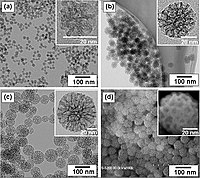
Photo from wikipedia
Abstract Aluminum nanoparticles (NPs) demonstrate a variety of applications. Here we study the laser-assisted generation of Al based NPs in liquids and in vacuum, and their ability to change the… Click to show full abstract
Abstract Aluminum nanoparticles (NPs) demonstrate a variety of applications. Here we study the laser-assisted generation of Al based NPs in liquids and in vacuum, and their ability to change the wettability and nonlinear optical properties of the surfaces, suspensions and plasmas. By means of Molecular Dynamics method we analyzed the formation process of aluminum NPs during the ablation of bulk targets. The numerical simulations allowed identifying the main mechanisms of NPs formation in liquid media and the existence of the optimal laser irradiation parameters for producing Al NPs of the desired size and morphology. We experimentally analyze the variations of the wettability of glass surfaces under the deposition of the NPs produced during laser ablation of aluminum in water and in vacuum. In the former case we demonstrate a significant decrease of contact angle leading to superhydrophilic properties of deposited NPs from water suspension. Meanwhile, the NP-contained films deposited on the glass substrates during ablation of Al in vacuum demonstrated the superhydrophobic features. The low-order nonlinear optical properties of Al NPs produced during ablation of the bulk metal by nano-, pico-, and femtosecond pulses are determined. The coefficients of nonlinear refraction and absorption of Al NPs using 40 fs pulses at λ = 400 nm were measured to be ~ 10-9 cm2 W−1 and 10-7 cm W−1, respectively. Al NPs allowed generation of 37th harmonic using 40 fs pulses propagating nearby to the ablating aluminum target.
Journal Title: Applied Surface Science
Year Published: 2020
Link to full text (if available)
Share on Social Media: Sign Up to like & get
recommendations!